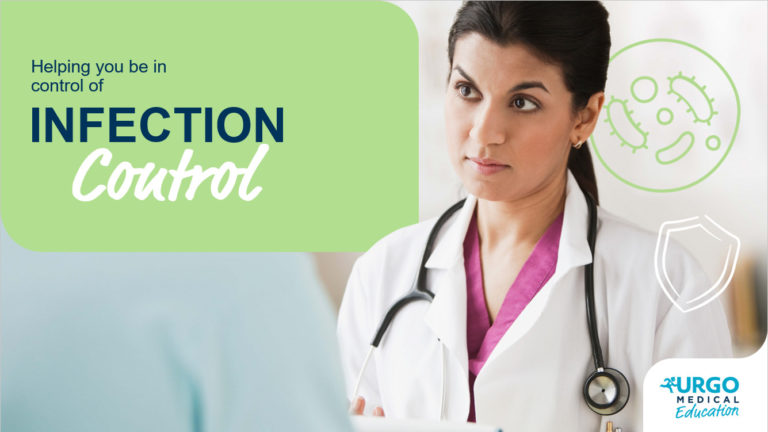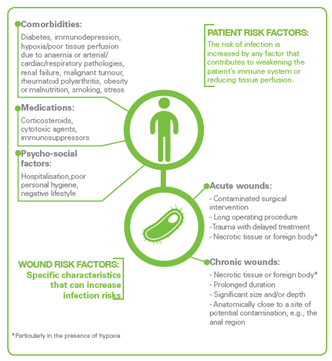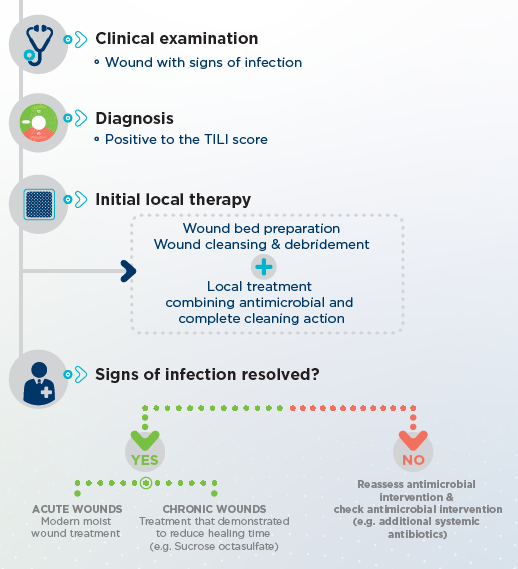
Bacteria are present on all type of wounds, but the bacterial balance of the wound plays a key role in healing.1 Infection is defined as an invasion and multiplication of microorganisms in body tissues, evoking an inflammatory response (systemic and/or local) and causing local signs of inflammation, tissue destruction, and fever.2
Infection is one of the most frequent complications of non-healing wounds 3 and has huge consequences:
- Delayed wound healing.
- Patient anxiety and discomfort.
- Hospitalization, amputation, and death.
For diabetic patients, an infected foot ulcer precedes 60% of amputations, and the risk of amputation was 154.5 times greater than those without foot infection.4
Infection contributes to increased costs for the health care system.5
- Each patient with a surgical site infection will require an additional 5 days in hospital.6
Cost to the NHS related to hospital acquired infection is £1 billion per year.6
Infection risks vary according to wound characteristics and the patient’s overall health and its susceptibility to infections. 11;12

Wound with debris, exudates and friable tissues is five times more likely to have critical colonization.5 The presence of these materials in the wound maintains an ideal environment for bacterial proliferation & biofilm formation10 Wound infection creates a vicious cycle that
causes tissue damage and delayed healing, to effectively prevent and fight against local infection a combined action is needed :
- A complete & continuous cleaning action
- An antimicrobial activity
A lot of signs are usually described in the literature to diagnose locally infected wounds (pain, heat, redness, …). But how to recognize the ones that matter? Identifying local infection in chronic wounds may be difficult. Clinicians need to rely on other signs and symptoms and there was no consensus on which signs to use. 7
This current situation has presently been analyzed by Urgo Medical with a panel of wound experts from seven European countries. The objective was to search and to propose for an easy-to-use clinical score for the early detection of local wound infection as basis for a local antimicrobial treatment decision.1 As a result, they published the TILI Score, a Therapeutic Index for Local Infection, a simple tool that can be used to diagnose a local wound infection 8;9

1. Sibbald RG, Woo K, Ayello E et al. Increased bacterial burden and infection: NERDS and STONES. Wounds UK. 2007; 3(2):25-46.
2. Gottrup, F., Apelqvist, J., Bjansholt, T. et al. EWMA Document: Antimicrobials and Non-healing Wounds—Evidence, Controversies and Suggestions. J Wound Care. 2013; 22 (5 Suppl.): S1–S92.
3. EWMA document: Antimicrobials and Non-healing wounds. Evidence, controversies and suggestions. JWC ,Vol 22. No 5 .2013.
4. Lipsky BA. Medical Treatment of Diabetic Foot Infections. Clin Infect Dis._2004;_39(Supplement 2):_S104-S114.doi:_10.1086/383271
5. Siddiqui AR, Bernstein JM. Chronic wound infection: facts and controversies. Clinics in Dermatology._2010 Sep-Oct;28(5):519-26.
6. Collier M. Recognition and management of wound infections. World Wide Wounds. 2004_01.
7. Dissemond J, Gerber V, Lobmann R, Kramer A. TILI (Therapeutischer Index für Lokale Infektionen) – ein neuer Score für die Diagnostik lokaler Wundinfektionen. Wundmanagement 2019; 13: 283-287.
8. J Dissemond, V Gerber, R Lobmann, A Kramer, D Mastronicola, E Senneville, C Moisan, V Edwards-Jones, K Mahoney, A Junka, M Bartoszewicz, J Verdú-Soriano, R Strohal. Therapeutic index for local infections score (TILI): a new diagnostic tool. Journal Wound Care. Dec 2020.29 ;12.
9. J Dissemond, R Strohal, D Mastronicola, E Senneville, C Moisan, V Edwards-Jones, K Mahoney, A Junka, M Bartoszewicz, J Verdú-Soriano. Therapeutic Index for Local Infections score validity: a retrospective European analysis. Journal Wound Care. Dec 2020.29 ;12.
10. Percival SL, Suleman L. Slough and biofilm: removal of barriers to wound healing by desloughing. Journal of Wound Care. 2015 Nov;24(11):498, 500-3, 506-10
11. World Union of Wound Healing Societies (WUWHS). Principles of best practice: Wound infection in clinical practice. An international consensus. London: MEP Ltd, 2008. Available from www.mepltd.co.uk
12. European Wound Management Association (EWMA). Position Document: Identifying criteria for wound infection. London: MEP Ltd, 2005.

